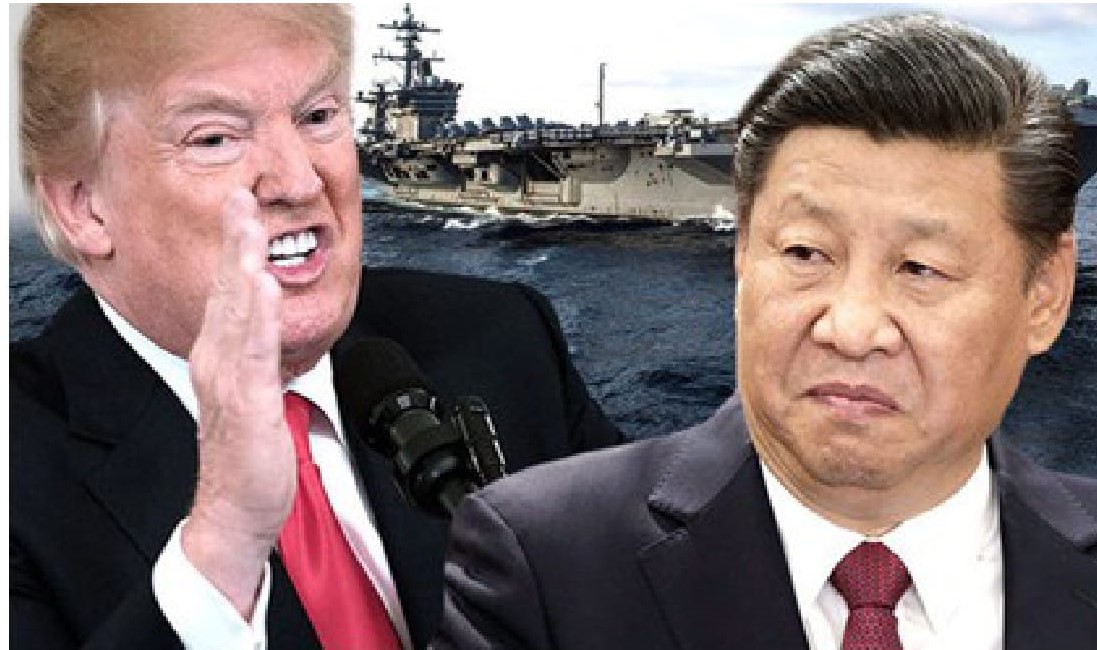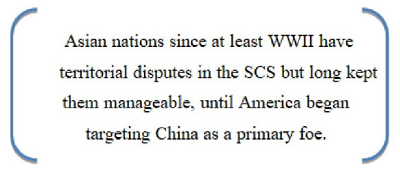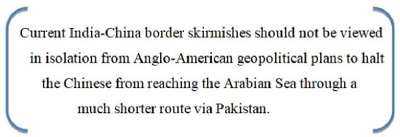Hemant Adlakha, Honorary Fellow, ICS and Associate Professor, JNU
Speaking of foreign affairs, in the early days of reform and opening door policy, Deng Xiaoping once said, China must continue to ensure good relations with the US. All other outstanding issues, including Taiwan and the dispute with Japan and ASEAN nations about the Diaoyu Island and South China Sea, Deng was confident that future Chinese leaders “with cleverer minds” would be capable of settling.

Recently, the South China Sea has become a flashpoint again. Why? To people who refuse to be labeled as pro-China or pro-US (though there really aren’t many such people around), the reason for waters heating up in the 3.5 million km2 sea is the showdown of strength between China, a continental rising power and the US, the world’s only dominant maritime power ruling the oceans for over a century now. While the mainstream media (MSM) – also the dominant view in the region, blames growing Chinese muscularity in the SCS, the non-MSM perspectives in the region and beyond, attribute further intensifying of the many-fronted aggression against China by the American Empire, especially during the ongoing Covid19 pandemic period, as the main source of the SCS again becoming a potential flashpoint.
As the battle of perceptions weighs heavily against the People’s Republic of China, it is intriguingly puzzling why three important aspects – crucial in the understanding of the prevailing venomous atmosphere in the SCS – remain hidden in the mainstream discourse. They are, namely: Asian nations since at least WWII have territorial disputes in the SCS but long kept them manageable, until America began targeting China as a primary foe and implemented its “Pivot to Asia” policy to contain China in 2011; the current, incendiary sovereignty battle in SCS is the result of four centuries of Western – American and European – colonialism which began with Spain and Portugal dividing the Philippines and Indonesia in 1529 and ended with the US and UK drawing borders separating the Philippines and Malaysia in 1930; finally and more importantly, the US maritime hegemony – an unchallenged Anglo-American sea power for over 200-years ensuring that 90 percent of global trade continues to use oceanic routes – cannot allow any country, especially a continental power like China, to change the international political order designed by the maritime world.

The Brazilian journalist Pepe Escobar, a regular columnist for Asia Times Online and Sputnik News, has been following developments in the SCS since Hilary Clinton started navigating the US return to “Asian waters” as the 67th US Secretary of State under the Obama Administrationin 2009. In July 2016, when the Permanent Court of Arbitration (PCA) at The Hague decreed in favor of the Philippines and rejected China’s claim of “nine dash line” regarding the disputed Spratlys, Escobar wrote “the SCS is and will continue to be the ultimate geopolitical flashpoint of the young 21st century.” Needless to point out, Escobar’s pronouncement had much to do with China’s instant, disdainful dismissal of The Hague judgment as “null and void.” But in fact, Escobar was reminding us of the future retaliation by the US against the Chinese “saber- rattling.”
Another pertinent argument which generally is missing from the mainstream discourse is that stakes are very high in tension-ridden SCS not only for the future of Asia, but also for the East-West balance of power, as compared with the Middle East or even in Eurasian borderlands. To understand this, one must read Alfred Mahan’s seminal The Influence of Sea Power Upon History, 1660-1783, written over a century and quarter ago. Mahan essentially wrote the roadmap of US ascendancy to become the world’s most powerful maritime power, and therefore the dominant power. His core thesis is, the US should go global in search of new markets, and protect these new trade routes through a network of naval bases. “That is the embryo of the US Empire of Bases – which de facto started after the Spanish-American war, over a century ago, when the US graduated to Pacific power status by annexing the Philippines, Hawaii and Guam,” Mahan had envisioned.
Echoing the above, a recent article in Wn.com/Defensepost on the ongoing eyeball-to-eyeball contestation between the armies of China and India along the Line of Actual Control in India’s eastern Ladakh, draws interesting connection between escalating tensions simultaneously in the SCS and on China’s western border with India, respectively. According to the article’s two authors, current India-China border skirmishes should not be viewed in isolation from Anglo-American geopolitical plans to halt the Chinese from reaching the Arabian Sea through a much shorter route via Pakistan. “US maritime power is asserting its reach and range to let its allies know that the ‘maximum pressure’ game on China is underway. Offensive realism, consisting of assertive containment and deterrence, is America’s new theoretical and military mantra against China,” it said.
When speaking of allies, a former Indian ambassador believes the ASEAN countries – almost all former or current allies of the US, may appear to be bandwagoning with China. In an op ed piece in The Hindu a couple of weeks ago, Ambassador Jayant Prasad opined: “But in spite of their deepening economic ties with China, they (ASEAN countries) are seeking political insurance, strengthening their navies, and deepening their military relationships with the United States.” On the other hand, while sympathizing with Beijing’s “self-defensive” actions, Thomas Hon Wing Polin, Hong Kong-based veteran journalist recently observed, “The SCS is home to the world’s busiest and most important trade lifelines. Some 80% of China’s overall trade including vital oil imports, all pass through its waters. Keeping SCS shipping lanes open is a core interest of China – simply because it is matter of national survival.” Polin also cautioned that the ASEAN nations are fully aware the island disputes is not with China alone, but also between and among several ASEAN members. To the huge discomfiture of the US, not only China knows this, China has been successful in rallying most ASEAN countries round two initiatives Beijing can take credit for: to settle disputes bilaterally and to have a Code of Conduct between China and the ASEAN.

Emerging from the just concluded virtual meeting of the ASEAN+3 Senior Officials Meet (APT SOM) last Monday, the Chinese Vice Foreign Minister Mr. Luo Zhaohui exuded confidence in the solid economic and trade ties between China and ASEAN. In the backdrop of the ongoing pandemic and in the face of escalating tensions in the SCS, the value of China’s exports and imports to ASEAN increased by 5.6 percent in the first half of this year, he said. Luo displayed the same confidence in East Asia to lead the world to recover economy. A statement released by the Foreign Ministry of the P R China (FMPRC) next day claimed: “As epidemic prevention and control becomes a new normal, regional cooperation East Asia has been reinforced. All parties are looking forward to signing the Regional Comprehensive Economic Partnership (RCEP) within this year. East Asia economic integration has bright prospects.”
Now, let us turn to China to see how scholars and experts have been evaluating both the heightened presence of the US marine power in the SCS, especially since early June; and whether the PLA Navy (PLAN) is actually planning to take on the US might, which is literally knocking at China’s doors. The overall consensus in Beijing regarding the presence of USS Ronald Reagan and USS Nimitz in SCS seems to dismiss any real or potential threat of war associated with the US move. Song Zhongping, a well-known military affairs commentator said in a recent interview with the Global Times, “The US move aimed at enhancing its military presence in the West Pacific, is designed to show off that its hegemony in the region is unshakable.” The US is also attempting to deter PLA movements in the SCS and on the Taiwan question, Song said.

Perhaps encouraged by Deng’s confidence in the ability of future Chinese “cleverer” leaders, or an indication that Beijing is moving towards a more hardened stance – in line with its so-called “aggressive” external posturing during the pandemic period, a recent article in the Party-run online current affairs news platform Utopia is worth paying attention. On the one hand, the article disdainfully calls for “reset” in Beijing’s long-held position of defining the SCS as “peaceful sea”; and on the other it makes an appeal to China’s policy makers to have “no more serious engaging with countries in the region with which China has territorial disputes.” Both propositions sound too extreme to seem tenable. Yet the fact that a major “official” media outlet has carried the signed article is enough to raise eyebrows among China watchers and security analysts alike, especially in the Philippines and Indonesia, or even in Malaysia, and raise the question, what is China up to?
Well, many would agree with the title of the op ed piece by the former Indian ambassador: “More saber-rattling, more isolation.” However, the moot question still remains, the SCS for Beijing will continue to be China’s South Sea or become “trouble sea” (nanhai). For nan in Mandarin means both “south” and “trouble.”